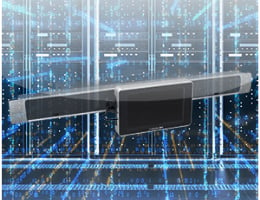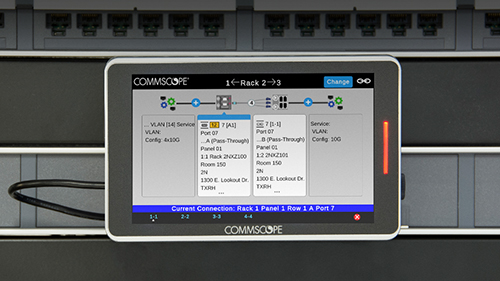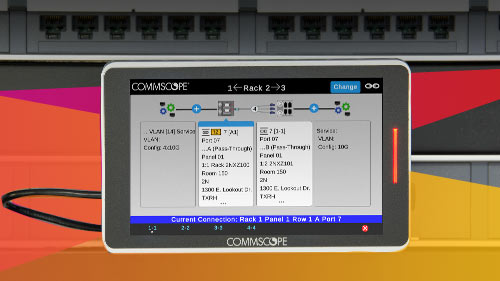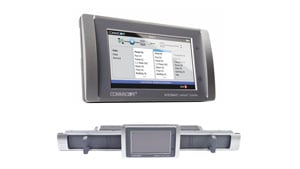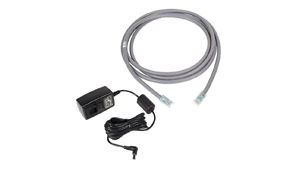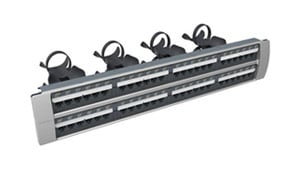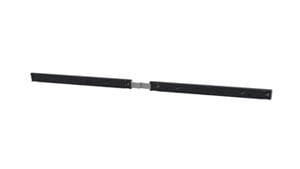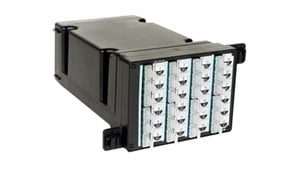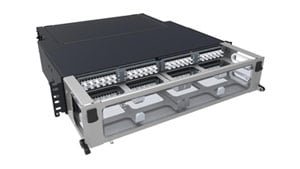Automated infrastructure management: the Fact File
Automated infrastructure management (AIM): the need to do more with less
Do you know how many switch ports you have currently available?
Can you locate any specific device in your network anytime and from anywhere?
Can you solve a cabling alert from a remote site without having to actually go there?
Do you know which outlets the laptops of your colleagues are physically plugged into?
If you want to learn more about how the automation wave has been changing cabling management and is now moving into using robotics and augmented reality, keep reading.
As the business and technology world continues to evolve, networking infrastructure just keeps improving. We have no choice. We have to connect more people at higher speed in more places than ever before.
As the performance of the network increases, though, so does its complexity. Heavily meshed leaf-spine architecture and point-to-multipoint connections make the orderly management and supervision of these networks difficult. On top of that, space is increasingly at a premium—giving us higher densities of ports on shelves, and an increase in the chance of human errors.
Oh, and as for the humans themselves, they are thinner in number and under more pressure than ever.
Fortunately, the network managers have automated infrastructure management (AIM) systems to support them, and this game-changing technology is described in greater detail in this fact file.
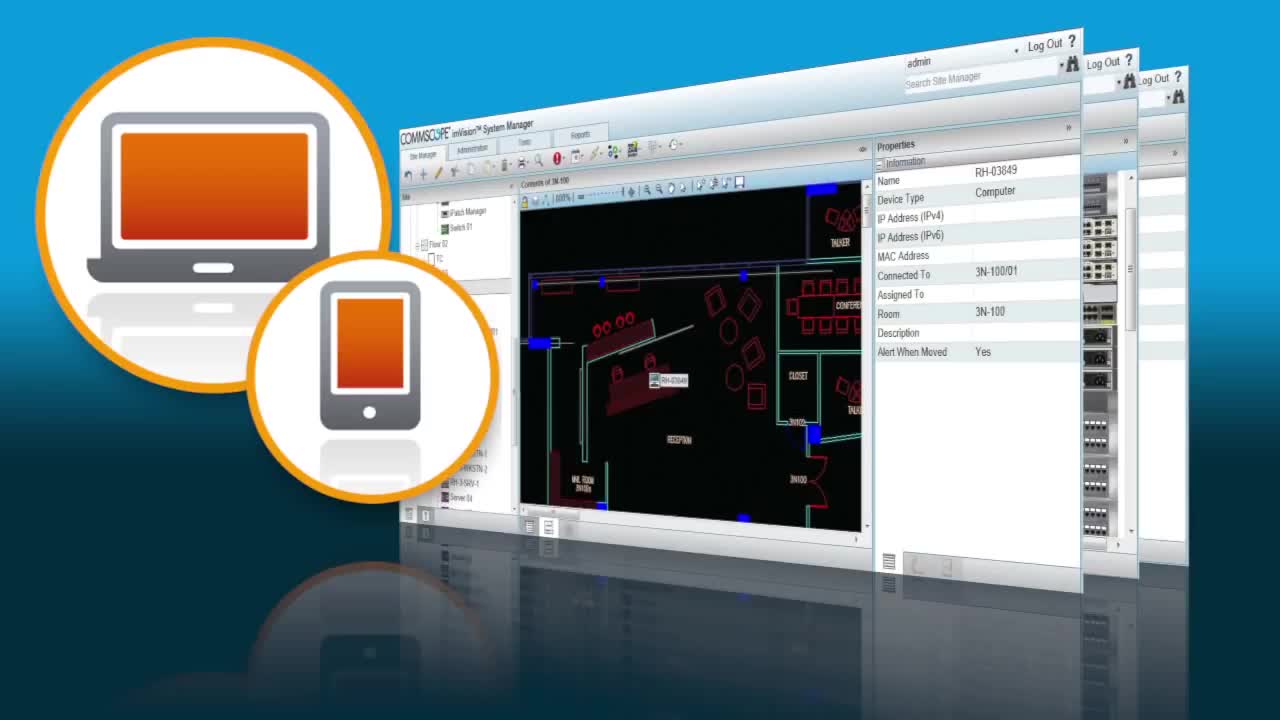
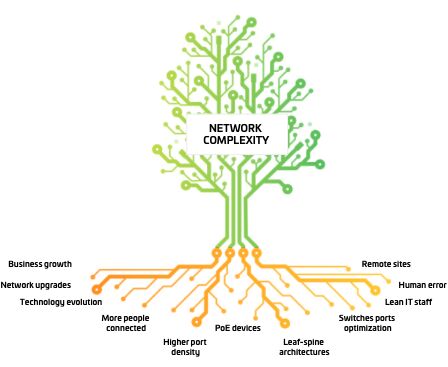
Would you like to read offline?
Download a PDF version of this article to read again later.
Stay informed!
Subscribe to The Enterprise Source and get updates when new articles are posted.
Let’s start with the formal definition from the ISO/IEC AIM standard: an automated infrastructure management (AIM) solution is an “integrated hardware and software system that automatically detects the insertion or removal of cords” and “documents the cabling infrastructure, including connected equipment—enabling management of the infrastructure and data exchange with other systems.” With its varied and powerful capabilities, from connectivity management and integration to MTTR reduction, AIM plays an important role in the planning, administration, and growth of enterprise networks.
AIM systems enable personnel to see, manage and optimize the connected environment in real time—enhancing the ability to manage the following issues:
Document cabling infrastructure
Automation Detection of the insertion and removal of cords
Network Device Discovery and their location information
Real-time monitoring of connectivity changes
What does an AIM system look like?
The network physical layer (also known as structured cabling) is the equivalent to your local road network. It provides the means to transport packages. If it comprised only roads, exits and roundabouts, it would be easy and would serve the intended purpose without problem.
However, all our infrastructures are getting smart or smarter. So we are adding traffic sensors, cameras to monitor the occupancy and detect issues, electronic displays to alert drivers, and even speed cameras (to the dismay of some drivers). All of that to better manage the road network complexity. You get the point...
An AIM system is that smart overlay on the cabling network. We will describe the main elements later, but it consists of hardware (intelligent panels, system controller and system server) plus the management software, whose role is to be the brain of the system.
Without AIM, there is only an electrical/optical connection between equipment at the ends...
...but, with AIM, you get the complete set of data about the end-to-end physical connectivity, including location information.
Do you recall the questions at the top of the page? AIM systems have all the answers.
AIM systems document end-to-end cabling infrastructure, including:
- Devices connected to the network
- Real-time monitoring and management of connectivity across an entire network
- Diverse and complex network cabling topologies
- Networks in intelligent buildings, data centers, and smart campuses
It is important to note that, although the initial detection of connectivity is generally accomplished through electrical, electronic, electro-mechanical or optical means, the different functions and features using this data are implemented in software.
As more applications and services come to market—each offering advantages in time, money or efficiency—it soon becomes impractical to monitor and manage the network manually. Thanks to various TIA, CENELEC, and ISO standards like ISO/IEC 18598, the role and potential of AIM solutions in the modern connected and efficient building are now established, unlocking a world of potential for enterprises.
How can you manage your infrastructure without AIM?
The best way to respond to this question is to ask those who have been working with AIM for some time; most of them wouldn’t like to return to the old, traditional methods to manage their infrastructure.
It’s difficult for us to imagine homes without broadband—or living without smartphones. However, though AIM is being widely adopted across enterprises and data centers, manual methods persist. Spreadsheets are often used to keep an “analog” record of connectivity systems—but the drawbacks are increasingly being highlighted.
The traditional manual documentation methods are less efficient, prone to inaccuracies and more time-consuming. Also, no matter how diligent, careful and expert your staff, human error will often arise. Automated infrastructure management systems are not only efficient and time-saving, they are becoming must-haves to support the network’s documentation needs for a high degree of reliability and availability.

If AIM was overly difficult to use it wouldn’t have been successful—so the operations had to be made easy.
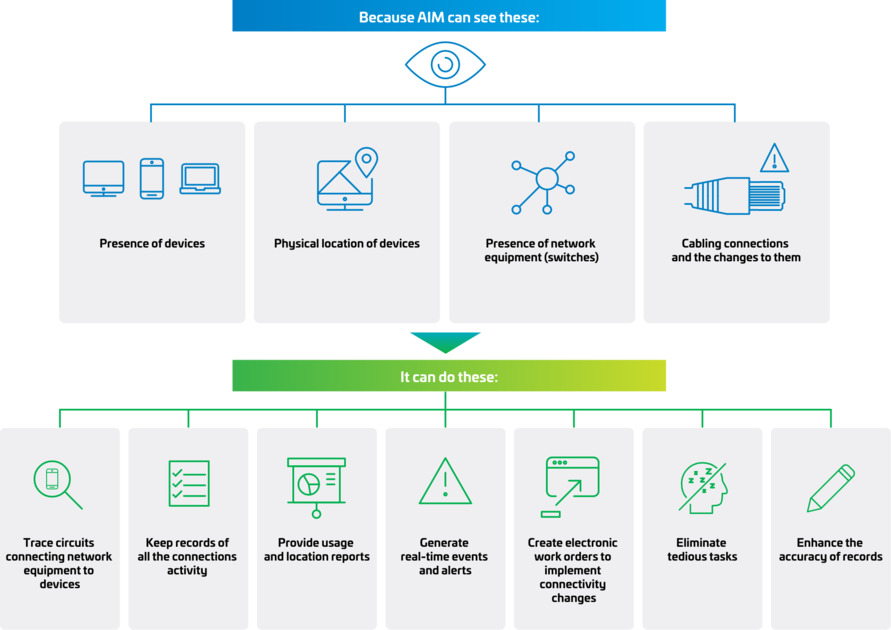
(Note: since the actual processes vary between AIM systems, we are using CommScope’s imVision® as an example in this section.)
End-to-end circuit trace
Every cabling manager and technician knows how frustrating it can be to trace a circuit from end to end. The entire circuit can span several floors and multiple cabling panels—not to mention the mess created by the countless patchcords on the front side of a rack. Most of the advanced AIM systems provide a smarter, easier way to trace complete circuits.

A trace function is initiated by pressing a port button that corresponds to one end of a patchcord connection. As a result, the system will light up port LEDs corresponding to both ends of a patchcord, thus making the task of circuit tracing very quick and efficient. Additionally, the entire end-to-end circuit trace information will be shown on the controller display. This makes it easy to visualize and manage the physical connectivity between network-connected devices, and all tasks can be undertaken directly at the rack’s controller.

Electronic work orders
Another key feature of any AIM system—especially (but not only) when you need to manage multiple remote sites or widespread campuses—is the ability to define and schedule required connectivity changes using the software and then send these instructions electronically to the controllers. This way a person responsible for implementing connectivity changes could easily retrieve these instructions directly from the controller display, and then, by selecting a specific work order, the system will provide visual guidance by illuminating the port LEDs that correspond to both ports. Once a work order is completed, the system will automatically send a notification to the software and update the connectivity database.

If it happens on your physical network, your AIM system will know about it. And not only can it see deep into your network’s complex, interdependent physical layer—and the myriad devices connected to it—it can also provide actionable insights, showing you exactly what you have and how different pieces interact.
But what is the business advantage of having this kind of automated network management? Broadly, it brings you three critical IT advantages:
1. Optimizing capacity
With its ability to track utilization of panel and switch ports, available space within racks, and cabling connectivity, AIM provides real-time data on how physical-layer assets are being used while assisting in the planning process. It can help you address capacity challenges without massive investments in additional infrastructure; rather, the tools within the system should reveal active components to show you where you can get more from the infrastructure you already have.
2. Optimizing availability
Visibility into end-to-end circuits means all changes are automatically fully documented. And, in the event of a network failure, a root cause analysis can be quickly established to help you get back online fast.
3. Optimizing efficiency and productivity
AIM solutions reduce time-intensive manual processes—generating electronic work orders and enabling the guided administration of connectivity changes, optimized server deployment and de-commissioning processes, minimizing human error and reducing the possibility of network downtime. Using AIM systems that provide this capability, the real-time management of the physical layer also ensures that stranded switch ports are identified and repurposed, rather than remaining idle while continuing to consume power.
AIM solutions reduce time-intensive manual processes—generating electronic work orders and enabling the guided administration of connectivity changes, optimized server deployment and de-commissioning processes, minimizing human error and reducing the possibility of network downtime. Using AIM systems that provide this capability, the real-time management of the physical layer also ensures that stranded switch ports are identified and repurposed, rather than remaining idle while continuing to consume power.
Without an AIM system in place, it is very difficult—if not impossible—to properly supervise the physical layer of your network if you are off-site, whether this means working outside office hours, during holidays, or simply dealing with remote sites.
Traditionally, one of the applications of AIM has been to flag up any unplanned disconnection of a key system. The management of remote sites gets a lot easier when status can be constantly monitored from anywhere. An advantage of AIM becomes a need if the remote locations are small-sized and do not warrant the on-site continuous presence of IT staff.
AIM systems are designed for remote management and monitoring of all infrastructure cabling, connectivity and performance. For example, some AIM systems can generate electronic work orders and send them directly to the system controllers.
The controllers then display on-screen instructions, thus eliminating a need for paper-based instructions, while the intelligent patch panels track implementation of these work orders in real time and enable the system to automatically record the successful completion of a work order.

Use of AIM systems can also minimize or perhaps even eliminate a number of site trips by non-local IT technicians to implement work orders. By providing clear and easy-to-follow instructions directly at the racks, the system can support implementation of connectivity work orders by mostly anyone. Practically any on-site individual—from engineers to security personnel—can execute the required tasks.

AIM systems like CommScope’s imVision provide real-time visibility, which means that, if the task wasn’t done according to instructions, the requester will be notified in real time and can contact the on-site individual to work through any difficulties.
In recent years, remote network management solutions have proven increasingly valuable—enabling tech response teams to work faster and more efficiently. In 2020, these systems quickly became a critical must-have for safe and responsive data center management. As early as April 2020, Data Center Knowledge reported: “Colocation providers are using online data center infrastructure management customer portals for remote monitoring and IT support ticketing... Colocation providers are also promoting their remote-hands services. These services cover things like IT equipment moves and additions1.”
Find out more in this white paper: imVision® addresses needs for remote network management due to pandemic
Managing Power over Ethernet (PoE)
With the rapid growth in power over Ethernet (PoE) devices and applications, some AIM solutions provide the ability to monitor power distributed over the structured cabling—from power source equipment (PSE) to powered devices (PD).
Single management platform for building applications
As more and more building applications (such as Wi-Fi, IP security, LED lighting, and high-definition audio/visual) utilize twisted-pair cabling, AIM provides the single management platform for the physical layer—tracking what had historically been separate IT and facilities networks.
Tracking end devices
With the proliferation of the number and variety of device types in smart buildings, AIM can provide location information on all connected devices. The location of wired devices can be made down to the outlet, and wireless devices can be tracked to the Wi-Fi access point with which they connect. This level of insight can help quickly identify and locate devices and users that may not be compliant with corporate network utilization policies, virus-infected computers, or devices that are not authorized to be connected to the network.

Manages ever-higher fiber port densities
AIM helps manage ultra-high-density systems: For example, CommScope’s imVision can handle up to 576 fiber strands in a 4U LC duplex shelf configuration. The minimized footprint helps contain rack space costs while reducing the risk of manual error in patching in an ultra-high-density environment.
Manages point-to-multipoint connection
AIM helps manage point-to-multipoint connectivity, which has become commonplace with the advent of 40G, 100G and emerging 400G Ethernet connections.
Manages switching fabric for leaf-spine architectures
Provides visibility, intelligence and control to meet the challenges associated with tracking the high number of interconnects in leaf-spine architecture, which has become a commonplace network architecture.

As networking infrastructure is increasingly used to carry power as well as data, so the task of network management becomes more complex. An automated infrastructure management (AIM) system such as CommScope’s imVision solution can automate such recordkeeping to help ensure standards-compliant designs are documented. It does this by correlating the real-time switch power usage per port with cable bundle size and cable type, since recommended bundle sizes are stipulated in TIA, ISO/IEC and CENELEC standards.
The number of cables in a bundle is a static number; however, the status of cabling related to PoE and data delivery changes due to the dynamic nature of connectivity between switch and panel ports.

Whenever connectivity changes are made, the AIM system automatically updates the cable status within a cable bundle, thus providing a real-time view of every cable bundle’s PoE state.
Most of the guidelines in cabling standards define a maximum cable bundle size based on the most demanding scenario of having all cables in a bundle delivering PoE Class 8 current (90 watts), as defined by the IEEE 802.3bt standard. However, in practice, not every cable in a bundle could be energized—or, if it is energized, it may not be to the level of PoE Class 8 current.
AIM systems like imVision automatically monitor the PoE state of each cable within a bundle in real time, so bundle sizes do not have to be constrained by the maximum size per the guidelines. Instead, network managers have the flexibility to use whatever bundle size is suitable for that installation.
Power over Ethernet is evolving fast and the number and variety of PoE-enabled devices in the enterprise continue to increase—underlining the need for sophisticated automated management tools. Several factors are driving this, including:
- 4PPoE standard (IEEE P802.3bt), delivering up to 90 watts to end devices
- Convergence of IT and facilities onto a common IP/Ethernet platform
- The internet of things (IoT) and its ever-growing ecosystem of connected devices
AIM systems have been developed by most of the major vendors in the structured cabling market. To separate the different components and their functions, we are taking the example of CommScope’s own imVision platform, which consists of three interrelated components (see Figure 1):
- Intelligent copper panels and fiber shelves, which monitor port usage
- imVision controllers, which monitor and track all real-time changes to the physical layer
- imVision System Manager software, which correlates connection data with information from networking equipment, IP endpoints, and other systems—providing a view of how network-connected devices layer map to the physical layer

Intelligent panels
Intelligent patch panels help intelligently manage copper and optical fiber cabling infrastructure. Working in coordination with the system’s controllers and management software, the panels provide real-time access to changes that occur in the physical layer of your cabling infrastructure.
It’s important to have a broad portfolio of intelligent panels available to avoid limiting your design options and the flexibility and adaptability of your network infrastructure. For copper connectivity, typically you would have options for 24-port 1RU or 48-port 2RU panels, straight or angled, that support Category 6 and Category 6A transmission performance.
Regarding the fiber connectivity and considering how key an AIM system can be for any data center, it’s important to count on a variety of possible connector interfaces, like simplex and duplex LC and MPO connectivity with support for OM3/4/5 or SM fiber.

System controller
The controller acts as the gateway for the AIM system—delivering the real-time information necessary to take precise control over network processes.
The controller simplifies the oversight of network connectivity changes by displaying the work orders generated by the management software. For ad hoc operations, all connectivity changes are detected by the controller and forwarded to the management software, which then generates notifications that are sent to systems administrators.
The CommScope imVision Controller X, for example, uses a capacitive touchscreen user interface, which can present more information than would be possible using traditional port or cord labels, thus allowing users to easily trace existing connections and the locations of patchcords and connected devices.

Management software
Management software allows you to document and monitor your cabling and network infrastructure through a standard web browser—providing you with a complete view of your physical infrastructure.
The software recommends optimal connections and initiates electronic work orders for operators, which is particularly useful for data center applications where a new server requires six or more connections. The software tracks the status of each work order and can alert an operations manager if a job is not completed on schedule.
When new connections are made, the software remotely traces the complete path from an end device (server, workstation, IP phone or printer) to the service-providing port on a switch.
To comply with the ISO/IEC AIM standard, the software has to provide either SOAP or RESTful APIs for integration with external systems and applications such as NMS, CMDB, DCIM, Asset Management and more.

The intrinsic capabilities of AIM are to provide real-time monitoring and automated management of the building’s structured cabling infrastructure and networked devices. The ISO/IEC 18598 standard subdivides these intrinsic benefits into the following areas:
![]()
Accurate documentation
This is the system’s ability to detect and document connections within the infrastructure and automatically update its database as changes occur. This includes the ability to automatically document a device’s entire connectivity trace from end to end, map the physical location of all connected elements, and display their location on building plans and layouts. The automated documentation capabilities of an AIM solution typically can drastically reduce or perhaps virtually eliminate the expected error rate associated with manually managed infrastructure systems, which can run to about 10 percent (as per a report from Digital Realty Trust).
![]()
Asset management
An AIM solution also provides detailed information on all network switches and end devices. According to ISO/IEC 18598, this includes identifying the physical location of every networked asset—room, rack, server, and port—as well as device properties like host name, MAC address, WWN and IP address. Among the obvious OpEx benefits of this granular capability are a faster mean time to repair (MTTR) and much less time spent on network audits. Additionally, asset management makes it easier to support and enforce bring-your-own-device (BYOD) policies—enabling IT personnel to quickly identify and locate unauthorized devices.
![]()
Capacity management
To lower CapEx, it’s critical to optimize the use of connectivity assets such as switch ports. By monitoring the real-time utilization and status of all ports, patch panels, shelves and work area outlets, AIM solutions identify inactive switch ports, find available rack space and locate unused panel ports. Such information can be useful to IT personnel in their effort to maximize existing resources and potentially defer costly capacity upgrades.
![]()
Change management
More than ever, employees and their connected devices are constantly on the move. An important section of the ISO/IEC AIM standards outlines the system’s ability to handle the moves, adds and changes of connected assets within the network. The standards specify the need for accurate and real-time connectivity information, technical guidance to minimize human errors, and the ability to support electronic work orders and track work order history. The standard also encourages users to look for systems with intelligent service and circuit provisioning, which eliminates the need to manually select connectivity paths and/or elements when adding devices.
![]()
Incident management
In the context of IT infrastructure, an “incident” is typically defined as any unscheduled or unauthorized change in connectivity status. According to the ISO/IEC 18598 standard, AIM solutions must be able to detect all incidents and create an audit trail that documents them as well as the corrective actions taken. This requires a sophisticated set of automated steps that must be completed across various components of the infrastructure, in real time. An example of the automated incident management capabilities of AIM (imVision) is shown in Figure 1.

To get best use from automated infrastructure management technology, standards need to be ratified and observed. The IT industry has recognized the important role intelligent infrastructure solutions can provide and has developed standards that encompass the capabilities and functions of these solutions, including the following:

US
TIA 606-B:
Administration Standard for Commercial Telecommunications Infrastructure, published in 2012
ANSI/TIA-5048:
AIM Standard
ANSI/TIA-5017:
Physical Network Security
Global
ISO/IEC 14763-2:
Information Technology—Implementation and operation of customer premises cabling, Part 2: planning and installation, Amendment 1
ISO/IEC 18598:
Automated Infrastructure Management (AIM) Systems—Requirements, Data Exchange and Applications—published in 2016
BICSI:
List of recommended management tools—BICSI 009-2019, Data Center Operations and Maintenance Best Practice
CommScope’s AIM-compliant imVision solution meets or exceeds these existing and other evolving standards..
Europe
CENELEC EN 50667:
AIM Standard
Besides the built-in, intrinsic benefits, AIM solutions could provide additional capabilities and benefits through integration with other systems and applications.
The AIM standard covers the following non-exhaustive list of systems and applications because of their importance and impact when linked with AIM systems:
IT-related systems:
- Internet protocol (IP) telephony management
- Network management software (NMS)
- Helpdesk or incident management applications
- Information security management systems
Building management systems:
- Energy management systems
- Lighting control systems
Data center infrastructure management (DCIM)
Configuration management database (CMDB) applications
For example, network management software can be integrated with AIM solutions like imVision to expand their existing ability for discovering network inventory based on a logical network mapping with details about physical connectivity between network devices along with the physical location of these devices. Additionally, an integration with NMS would allow for consolidation of all alerts related to network elements in a single console to streamline network fault management by correlating alerts received from network elements as well as from cabling infrastructure. This is provided by the ability of AIM systems to generate events about a status change in cabling infrastructure and forward these events as SNMP traps to network management software applications.
Equally, benefits can be gained by integrating AIM into IT workflows through helpdesk applications. This integration could add automation to service ticket creation, real-time notifications, monitoring of its implementation progress, and automatic update of a service ticket status and cabling documentation upon completion of the service ticket activities. Additional benefits include the ability of helpdesk operators to remotely troubleshoot and resolve any service disruptions due to connectivity-related issues.

AIM solutions are designed to help IT managers monitor and control most aspects of their network infrastructure—from tracking down a stranded switch port to troubleshooting a connectivity issue—in a matter of minutes versus hours or days.
But augmented reality takes it a step further. What happens when you have equipment and cabling hidden behind walls and ceilings? How about if you walk into a room with multiple panels and unnamed/unmarked ports? By incorporating AR capabilities into AIM, companies like CommScope are aiming to dramatically speed up troubleshooting and provisioning tasks.
The principle is that, when network managers look at something like a rack containing servers and switches, the AR headset superimposes (overlays) all sorts of additional information over what they are seeing, such as port numbers and other data. Similarly, if they walk into a room and look up at the ceiling, their AR headset will augment what they are seeing with graphical depictions of whatever is hidden out of sight, such as cabling and other equipment.
Since 2018, CommScope has been working with various partners on exploring use cases for AR technology that would potentially take AIM to a new level in addressing customer needs. A good example would be enabling a user to expediently identify, locate and navigate to a piece of faulty equipment, identify accurate placement and installation of new equipment, or access step-by-step guidance for maintenance tasks.

Augmented reality in the age of COVID
Given the recent need for both remote working and social distancing, CommScope has been using an AR platform (a third-party off-the-shelf solution, not integrated with imVision) to enable field personnel to connect with an expert within the company to guide them in carrying out maintenance activities thousands of miles away.
The processes associated with configuring hardware components requires a certain knowledge and skill set, and customers have been unable to have an expert on-site due to the pandemic. Through the above-mentioned third-party AR platform, a remote expert has been able to use the tool to remotely guide less knowledgeable personnel through the hardware configuration. The computer vision algorithms allow the user to attach virtual texts and symbols such as arrows, warning signs, and circles to provide and receive indications during remote support sessions.
In a post-pandemic world, AR will still have great economic advantages. Augmented reality means a considerable decrease in travel costs and the completion time of the operation. At the same time, other advantages may be the quick and interactive knowledge transfer and the ability to maintain a high level of customer service. Whichever way you look at it, AR is likely going to make AIM systems more effective, easier to use and beneficial to the business.
Augmented reality is not the only new technology that will enhance the way we manage our network infrastructure. Prototypes of data center robots have been produced that integrate with AIM systems, —taking their instructions directly from AIM and making the necessary adjustments to the hardware. Without human error!

Source: NTT Technology Experience Lab (Frankfurt / Main, Germany)
CommScope’s own AIM solution, imVision, has been deployed in different industries and to address different specific challenges in a number of countries around the world. Use the interactive tool below to find details of customer stories relevant to you. Click on your industry in the panel on the left, and choose from the examples that appear.
Below are interviews with some of CommScope’s partners, who are using AIM to improve workplace utilization, enhance security, reduce mean time to repair and much more.

LMG using CommScope imVision for managed services
LMG, a leading provider of IT and facilities infrastructure services, uses imVision® to help customers better manage office space and save millions of pounds per year.

Excel IT managing office space with CommScope imVision
For IT infrastructure company Excel IT, imVision’s device discovery gives customers the data to better understand location of network assets, its users and relate this information to their space requirements and, in one case, eliminate the cost of an entire building.

Redstone deploys CommScope imVision for workplace management
At Redstone, a provider of infrastructure and smart building services, imVision works with the OneSpace occupancy management system to map desk utilization and availability in real-time, and aid in the office space planning using electronic work order feature for moves, adds and changes.

NG Bailey utilizing CommScope imVision for managing workspaces
imVision’s enhanced security, automated device location and auditing capabilities enable IT services provider NG Bailey to tailor a managed services program to the needs of each customer.
This fact file is designed as a summary of useful information about automated infrastructure management systems—which is why most of the information you have read refers to that area of technology in general. CommScope is, however, understandably proud that our own imVision system is the market-leading solution. Here are a few reasons why:
![]()
The only AIM solution on the market continuously available globally since 2001.
![]()
The only AIM system that supports using standard copper and fiber patch cords and the only that supports three different sensing technologies.
![]()
Customers in 65 countries. The software interface supports 15 different languages.
![]()
Around 20% of top banks in the world
![]()
Largest customer manages over 500K of intelligent ports
![]()
Number of Certified imVision specialists = 300+ (144 accredited imVision partners)
![]()
Over 1,200 supported network switches from 30 vendors.
![]()
Used as a blueprint for the AIM standards.
![]()
Currently, the imVision system is the only AIM system that complies with requirements for PoE monitoring.
![]()
The only AIM solution that supports field upgrade without disruption of network service and modification of patch cords.
![]()
Over 90 patents covering AIM technology.
![]()
Celebrates its 20th anniversary in 2021 – making it the same age as Wikipedia, the iPod and the Xbox!

Video: Managing Critical Data Center Fiber Connectivity with imVision
Data center traffic, including fiber density, continues to grow. But, with imVision, you no longer need to choose between high density fiber and physical layer management.
How Automated Infrastructure Management is showing its human side
AIM is not only about software-driven automation, it helps make people operate more effecitively too.


